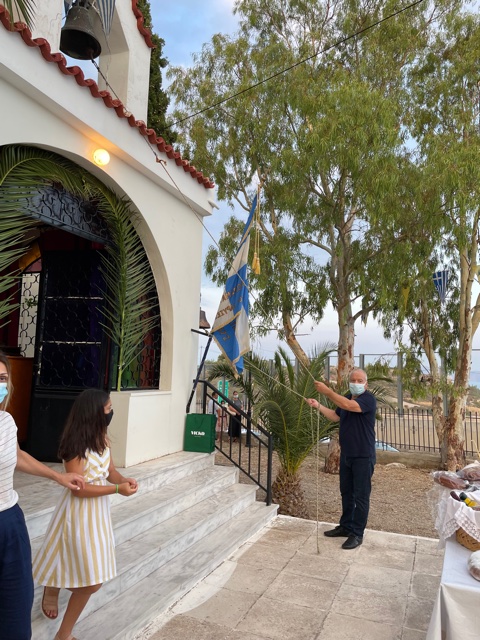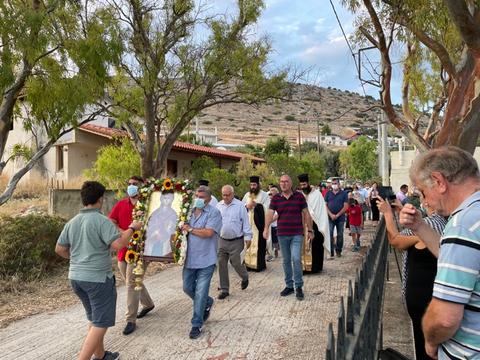Chios Marine Club honours St. Marcella*

On the eve of St. Marcellas’ sacred Nameday, a group of members of the Chios Marine Club, headed by its president Capt. Antonis Pitsilos gathered at the chapel of Saint Marcella at Panorama – off the City of Megara overlooking Salamis and the Saronic Gulf in western Attika, for the annual liturgy in honour of the Saint. The spot was found by member Konstantinos Achladitis passing by one day from the highway leading to Corinth and it was more than worth for a pilgrimage, particularly during these Covid-19 period we witness and travelling is not that appropriate for all to participate at the St. Marcella’s shrine at Volisos.

The chapel was built by Aetoloacarnean Konstantinos Bekiriakis – with assistance and donations by the locals of Panorama settlement, who insisted for the name honouring his wife Despina and mother-in-law Kiriaki Kolaki from Vrontados, Island of Chios in the Aegean Sea (other proposed names included St. Lavrentios and Analypsis). The land was offered by industrialists Staikopoulos, Baras and Tsakiriakis. Works begun in 1972 and the first service in 1984.

Father Alexandros officiated assisted by fathers Polieftos and Anastasios. Over 250 faithful followed the Holy Litany almost all wearing protective masks. Per the Chian and Orthodox tradition, Emmanouel Lamprinakis – another member present from the Chios Marine Club, rung mournfully the chapel’s bell and Konstantinos Achladitis carried one of the sacred fans (hexapteryga) during the holy litany of the Saint’s Icon.

In Chios, most families have christened their daughters Marcellas; many vessels are named after the Saint: Santa Marcella, Aghia Marcella, St. Marcella, Marcella…

* The Chian Saint with a unique history, far beyond the mythos… It will be a unique experience for all women to try and find, read and study same! Research and you will find out! The place of her martyrdom, the most apocalyptic one in the wildest environment that not even your imagination can make… Worth paying a visit to the Island of the Winds when things ease down given the COVIID-19 mess and see what I mean. Many Happy Returns for their Nameday tomorrow to all Marcellas’ and Marcellos’ – as it’s also a male name too!

Moreover, my friend Marcella Shivhaktiyoga sent me the following last year – another version from what we know:
Saint Markella (also Marcella) was an inhabitant of Fourteenth Century Chios, Greece who was canonized by the Greek Orthodox Church. Her feast day is celebrated on July 22.
Saint Markella was born and lived in Volissos, Chios, Greece. She was raised as a devout Christian by her mother. However, her father (in some accounts) was a pagan.
Markella lived during the fourteenth century – during most of which Chios was under Genoese rule. At a young age, her mother died and Markella continued to study her Bible, pray to God and live a life according to what she was taught.
Around the time of her eighteenth birthday, the virtuous Markella had to flee the fury of her violent father. There are variant accounts given about the reasons for that. In one version, while Markella’s late mother had been a Christian, her father was an idolater and he tried very hard to force his daughter to become an idolater, too; this seems anachronistic, since by the 14th Century paganism was long since extinct in Greece. By another version, the problem was that Markella’s father was consumed with incestuous lust for her, and she fled in horror when he declared his intentions.
Whatever her reason for being afraid of her father, Saint Markella fled to nearby mountains and hid in a bush. Her father found her with the help of a local herdsmen, and they set fire to the bush to force her to show.
Markella ran to the sea to escape but her father aimed an arrow at her and wounded her. As believed by the local people, The blood of the saint dyed the rocks and to this very day, during the festivities for her feast day, at a specific time, her blood becomes visible on these rocks for all the faithful who bear witness to this miracle.
It is further believed that as she was injured, she prayed to Jesus – her final moments spent in prayer requesting that the rocks would open for her to hide from her father and this happened. However, the opened rock enabled her to hide all of her body inside, but not her head. Her father decapitated her and threw the head into the sea. Her head floated to the nearby beach of Komi.
For many years, the locals could not locate the head until one day an Italian (presumably Genoese) warship was in the area. In the evening, the Italians could see a bright light coming from the distance and when they got closer they witnessed a head, floating in the water, lit by upright floating candles. Immediately, they realized that this was a sacred miracle they were witness to and they took the head of the Saint back to their homeland.
Local tradition also has it that holy water springs from the rocks that mark her martyrdom. Many pilgrims visit this location and every year on 22 July, during the commemoration services for the Saint, the holy sea water in the rock pool boils during the entire Paraklisis Service; this phenomenon only occurs in the presence of a priest. If a pilgrim’s faith is strong, a local tradition is that the water in the rock-pool will feel extremely warm to touch.





